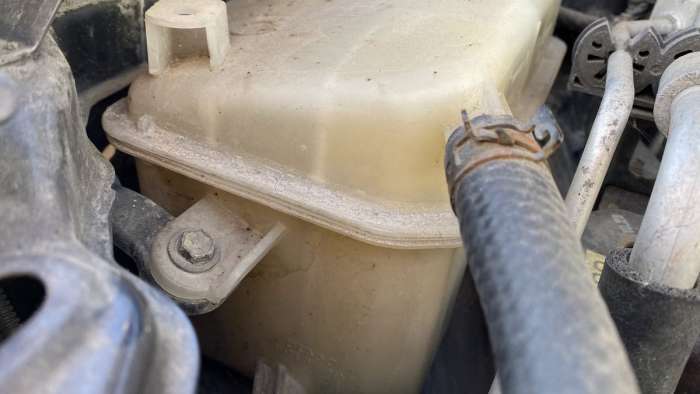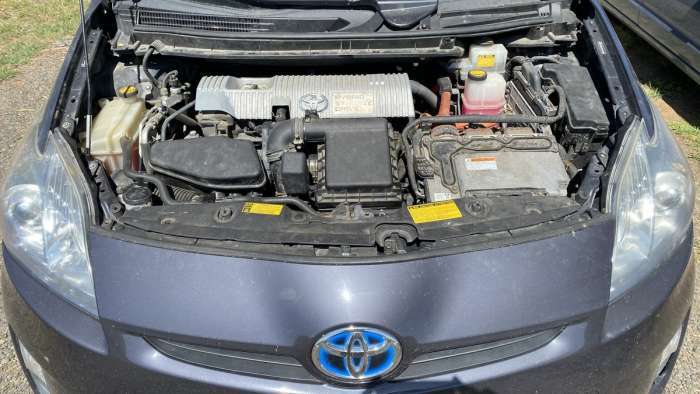I think one of the most annoying things about owning a 2010 (Gen 3) Prius is the head gasket failure. I recently purchased one 800 miles away from my house and now have the task of getting it home.
I have spent the past few days with it and have figured out how to get it home without using any block sealer. I am not a proponent of the chemical, so using it goes against repairing it the right way. That is not to say block sealer would not work, it can, but I do not want to cause more problems.
After getting the dreaded "death knock" on startup, I decided to try something as a last-ditch effort. The idea behind doing this trick is not to fix the car but limp it along until I can get it home and repair it properly.
What Is The Trick And Why It Works
When 3rd Gen Prius starts to have a failing head gasket, typically, the breach allows coolant to seep into the combustion chamber and then cause the knock.


Coolant does not rush into the cylinder quickly; it only seeps in once the cooling system has pressure applied to it. So if you do not want coolant getting into the cylinder every time you shut the car off, what do you do? The answer is incredibly simple.
Gen 3 Prius uses a coolant expansion tank that allows you to remove the cap even when hot (as long as the system is not over full). While this initially went against the safety mechanism in my brain, I have repeatedly tested the method to ensure consistent results.
Every time I have driven the car long enough to get it good and hot when I park it, I open the hood and release the pressure from the cooling system. When there is no pressure in the system, the coolant cannot leak into the cylinder and foul it on startup.
Conclusion
Doing the process that I have recently described is better than entirely removing the "O" ring from the cap.
A cooling system is effective when under pressure. To relieve that pressure will only cause more issues, especially under heavy loads.
Periodically taking the cap off after driving the car will do everything you need it to do without compromising the vehicle while driving. The periodic stop and start with Prius will also not be affected by this procedure either.
I have driven the car now for several days doing this. The check engine light was on for a misfire but has gone out and not returned because the car is not misfiring on startup.
Overall, you need to repair the head gasket or replace the engine so it will work properly. The Head gasket sealer will limp the car along until it also fails. If your Prius is doing the dreaded misfire on startup, try pressure release after every drive.
My 800-mile trip is coming up quickly, and I intend on pushing the limits of the car, but I also want to make it home. So look for another post-trip article coming soon.
That is all for today; thank you for reading. Remember, today's adventure is tomorrow's story.
Trouble with your Toyota dealer? Join the club.
Check out this wild new battery tech that Tesla has and why it will forever change the auto industry.
Also, watch Toyota suddenly bringing its BZ4X electric SUV concept to United States on Torque News Youtube channel and please subscribe us on Youtube and follow on Twitter for daily Toyota and EV news reports.
Peter Neilson is an automotive consultant specializing in electric cars and hybrid battery technologies. He holds a Bachelor of Science in Automotive Service Technology from Weber State University. Peter can be reached on Linkedin and you can tweet him at The_hybrid_guy on Twitter. Find his page on Facebook at Certified Auto Consulting. Read more of Peter's stories at Toyota news coverage on Torque News. Search Toyota Prius Torque News for more in depth Prius coverage from our reporter.













Comments
Thanks Peter. I have that
Permalink
Thanks Peter. I have that dreaded “death knock” on my 2010. gas going through the roof I do no need this but this little car
has been a gem.
I gather after you release
Permalink
I gather after you release the pressure you put the cap back on and leave it on until you park again after heating the car up.>
I bought a 2012 Prius vehicle
Permalink
I bought a 2012 Prius vehicle in Feb 2022. I had not done my research & soon discovered the dreaded rattle& roll on startup. I thought of depressurizing myself and have been doing it since then. (so was happy to discover this blog) .No more symptoms but of course the coolant level slowly going down. Before head gasket replacement I need to find out everything I possibly can about what else might be done at the same time to make the job the best. 85000 miles.
I bought a 2012 Prius vehicle
Permalink
I bought a 2012 Prius vehicle in Feb 2022. I had not done my research & soon discovered the dreaded rattle& roll on startup. I thought of depressurizing myself and have been doing it since then. (so was happy to discover this blog) .No more symptoms but of course the coolant level slowly going down. Before head gasket replacement I need to find out everything I possibly can about what else might be done at the same time to make the job the best. 85000 miles.
I love this article. I
Permalink
I love this article. I discovered the dreaded knock on my 2012 Toyota Prius on a long distance trip recently. My car has 260k miles, so I'm not going to replace the head gasket (way too costly).
By the way, does anyone know if the 2015 is also impacted? It's the last year of the Gen 3 model.
2013 prius owner faced with
Permalink
2013 prius owner faced with recommendation to replace engine... Maybe this is naive of me, but if this is a known issue ("the dreaded knock", "the dreaded rattle&roll", etc), shouldn't Toyota be required to do something about it?
And Peter, did you get home safe after all?
Late in the day, but:
Permalink
Late in the day, but:
The one way to avoid a blown head gasket, is to clean the entire EGR system of carbon (including the EGR passages in the intake manifold), at least every 50k miles.
Toyota screwed up on this, and this is the penance third gen owners are lumbered with.